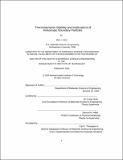| dc.contributor.advisor | W. Craig Carter and Samuel M. Allen. | en_US |
| dc.contributor.author | Siem, Ellen J. (Ellen Jane), 1979- | en_US |
| dc.contributor.other | Massachusetts Institute of Technology. Dept. of Materials Science and Engineering. | en_US |
| dc.date.accessioned | 2005-09-26T15:56:06Z | |
| dc.date.available | 2005-09-26T15:56:06Z | |
| dc.date.copyright | 2005 | en_US |
| dc.date.issued | 2005 | en_US |
| dc.identifier.uri | http://hdl.handle.net/1721.1/27874 | |
| dc.description | Thesis (Ph. D.)--Massachusetts Institute of Technology, Dept. of Materials Science and Engineering, 2005. | en_US |
| dc.description | This electronic version was submitted by the student author. The certified thesis is available in the Institute Archives and Special Collections. | en_US |
| dc.description | Includes bibliographical references (p. 168-180) and index. | en_US |
| dc.description.abstract | (cont.) Generally, a boundary is nonplanar in the neighborhood of an attached particle--even when anisotropic interfacial free energies do not produce faceting-and maintains a icKy = 0 while the boundary particles maintain a nonzero ,Ky. This is consistent with independent observations of Pb-rich particles at grain boundaries in dilute Pb-AI alloys. Predicted particle/boundary morphologies give a trade-off between boundary and particle interface-a particle replaces some boundary but also produces boundary area through local distortions. This result has several implications. The transition to perfect wetting requires a larger boundary energy density. The steady-state heterogeneous nucleation rate is increased when facets appear on the nucleus, but the increase is diminished if the boundary distorts. A corollary result presented in this thesis, that particles can induce rotations or ser- ration through torques, has implications in microstructural stability and illustrates avenues for future research. | en_US |
| dc.description.abstract | Many material properties depend on grain and phase boundary morphology. Equilibrium boundary and particle morphologies are determined by their interactions through interfacial free energy. Currently, the determination of boundary and particle morphology is, for most materials systems, experimentally difficult. This thesis demonstrates that geometric constructions from capillarity theory for anisotropic interfaces cannot predict boundary and particle morphology, even in systems with uniform temperature, pressure, and chemical potentials. In this thesis, numerical methods are developed and implemented for calculations of anisotropic particles of fixed volumes attached to one or more interfaces that are also subject to specified constraints. Some boundary properties can be found experimentally, such as: the crystallographic misorientation across the boundary, the fixed average unit normal to the boundary, the Wulff shape (W') of the boundary, and the particle W'4 within each grain or phase abutting the boundary. These properties become model parameters in addition to the W' associated with each interface. This thesis also presents methods of generating algebraic expressions for interfacial free energy densities, W' (n), that produce W for a given symmetry. Calculated examples show that equilibrium configurations are formed from portions of the boundary and particle /s and do not contain orientations absent from the respective W's. Under the constraint that the pressure difference across a boundary is zero, the boundary will develop a constant weighted mean curvature (Kic) of zero. | en_US |
| dc.description.statementofresponsibility | by Ellen J. Siem. | en_US |
| dc.format.extent | 183 p. | en_US |
| dc.format.extent | 43945802 bytes | |
| dc.format.extent | 60057460 bytes | |
| dc.format.mimetype | application/pdf | |
| dc.format.mimetype | application/pdf | |
| dc.language.iso | en_US | |
| dc.publisher | Massachusetts Institute of Technology | en_US |
| dc.rights | M.I.T. theses are protected by copyright. They may be viewed from this source for any purpose, but reproduction or distribution in any format is prohibited without written permission. See provided URL for inquiries about permission. | en_US |
| dc.rights.uri | http://dspace.mit.edu/handle/1721.1/7582 | |
| dc.subject | Materials Science and Engineering. | en_US |
| dc.title | Thermodynamic stability and implications of anisotropic boundary particles | en_US |
| dc.type | Thesis | en_US |
| dc.description.degree | Ph.D. | en_US |
| dc.contributor.department | Massachusetts Institute of Technology. Department of Materials Science and Engineering | |
| dc.identifier.oclc | 60822325 | en_US |
